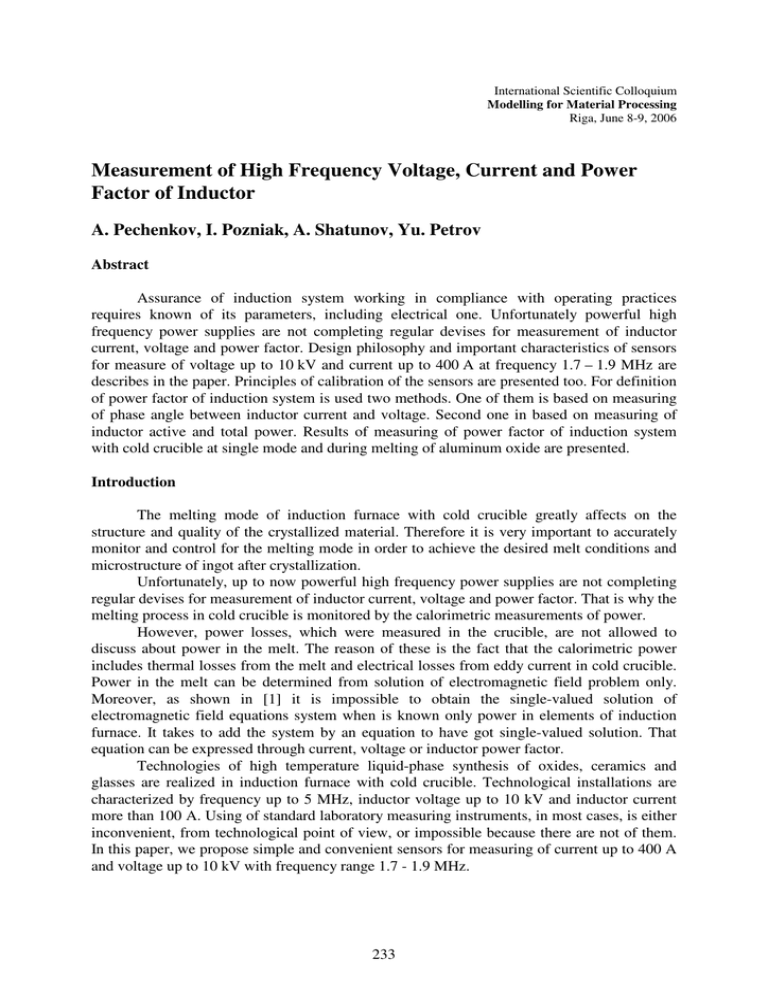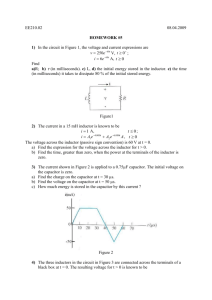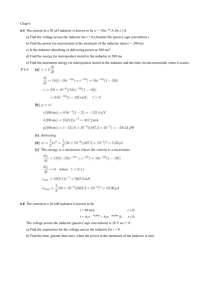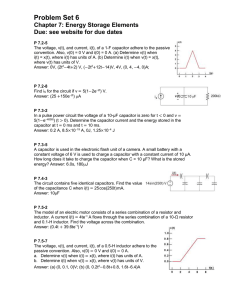Measurement of High Frequency Voltage, Current and Power Factor of Inductor
advertisement

International Scientific Colloquium Modelling for Material Processing Riga, June 8-9, 2006 Measurement of High Frequency Voltage, Current and Power Factor of Inductor A. Pechenkov, I. Pozniak, A. Shatunov, Yu. Petrov Abstract Assurance of induction system working in compliance with operating practices requires known of its parameters, including electrical one. Unfortunately powerful high frequency power supplies are not completing regular devises for measurement of inductor current, voltage and power factor. Design philosophy and important characteristics of sensors for measure of voltage up to 10 kV and current up to 400 A at frequency 1.7 – 1.9 MHz are describes in the paper. Principles of calibration of the sensors are presented too. For definition of power factor of induction system is used two methods. One of them is based on measuring of phase angle between inductor current and voltage. Second one in based on measuring of inductor active and total power. Results of measuring of power factor of induction system with cold crucible at single mode and during melting of aluminum oxide are presented. Introduction The melting mode of induction furnace with cold crucible greatly affects on the structure and quality of the crystallized material. Therefore it is very important to accurately monitor and control for the melting mode in order to achieve the desired melt conditions and microstructure of ingot after crystallization. Unfortunately, up to now powerful high frequency power supplies are not completing regular devises for measurement of inductor current, voltage and power factor. That is why the melting process in cold crucible is monitored by the calorimetric measurements of power. However, power losses, which were measured in the crucible, are not allowed to discuss about power in the melt. The reason of these is the fact that the calorimetric power includes thermal losses from the melt and electrical losses from eddy current in cold crucible. Power in the melt can be determined from solution of electromagnetic field problem only. Moreover, as shown in [1] it is impossible to obtain the single-valued solution of electromagnetic field equations system when is known only power in elements of induction furnace. It takes to add the system by an equation to have got single-valued solution. That equation can be expressed through current, voltage or inductor power factor. Technologies of high temperature liquid-phase synthesis of oxides, ceramics and glasses are realized in induction furnace with cold crucible. Technological installations are characterized by frequency up to 5 MHz, inductor voltage up to 10 kV and inductor current more than 100 A. Using of standard laboratory measuring instruments, in most cases, is either inconvenient, from technological point of view, or impossible because there are not of them. In this paper, we propose simple and convenient sensors for measuring of current up to 400 A and voltage up to 10 kV with frequency range 1.7 - 1.9 MHz. 233 1. Measurement principles and design of the sensors Necessary conditions for design of the current and voltage sensors were galvanic disconnection between input and output circuits, absence of waveform distortion, performance reliability of the units at voltage up to 10 kV, current up to 400 A and frequency 1.7 – 1.9 MHz, working with required load and simplicity of its calibration. Moreover, the sensors should be simple, compact and inexpensive. The elaborated voltage and current sensors was constructively designed as voltage transformers. Electrical scheme of the sensors are shown on the Fig. 1 and Fig. 2. Characteristics of output parameters of both sensors allow using analog voltmeters and analog-to-digit converters as load. RS XS R1 Uinp1 0...300 V V V W3 W2 W4 R1 0...150 V V V ~10 kV emf R2 W1 0...10 V Oscilloscope Fig. 1. Scheme of the current sensor Uinp2 R2 0...10 V Oscilloscope Fig. 2. Scheme of the voltage sensor General view of current and voltage sensors are presented on the Fig. 3 and Fig. 4 accordingly. The current sensor is positioning between inductor current-carrying busses (Fig.5) where it is provided magnetic flux uniformity. The voltage sensor is positioning as near as at inductor (Fig. 6). Fig. 3. Current sensor Fig. 4. Voltage sensor without front panel Fig. 5. Position of the current sensor Fig. 6. Position of the voltage sensor 234 Tab. 1. Features of inductor current and voltage sensors Features Current sensor Voltage sensor Frequency range 1.7 – 1.9 MHz 1.7 – 1.9 MHz Galvanic uncoupling of Yes Yes output signal Measuring signal Max 400 A Max 10 kV Output voltage range: 10 V 10 V Rload≥2 kOhm, C≤25 pF 300 V 150 V Rload≥1MOhm, C≤25 pF Change a waveform of No No input signal Operating mode Long duration Long duration General features of the current and voltage sensors are presented in the Tab. 1. Calibration of the voltage sensor were carried out by means of using of static voltmeters. Calibration of current sensor is based on definition of inductor current trough the Ohm’s low: r I ind = r U ind 2 2 rind + X ind , were rind - inductor active resistance and X ind - reactance of inductor can be measured by r LCR meter and U ind - voltage at inductor is measured at working installation. 2. Definition of inductor power factor 2.1. First approach Current and voltage signals are fixed by oscilloscope Tektronix TDS3054B by 10 thousand points with time step 0.2 ns. It is corresponded about 3.5 periods of the harmonic function. Such measurements are realized several times for each operating modes. Postprocessing of the experimental data by least-squares method gave us phases of current ϕ I and voltage ϕU signals. Each of those values includes two items: ( ϕU = ϕU ind + ϕU s ( ) ) ϕ I = ϕ Iind + ϕ I s , were: ϕUind - phase angle of inductor voltage; ϕ Iind - phase angle of inductor current; ϕU s phase shift of phase angle of inductor voltage by voltage sensor; ϕ I s - phase shift of phase angle of inductor current by current sensor. Phase angle between measured signals is: ϕU − ϕ I = (ϕU + ϕU ) − (ϕ I + ϕ I ). ind s ind s Regroup the items: ( ) ( ) ϕU − ϕ I = ϕU ind − ϕ Iind + ϕU s − ϕ I s , were phase shift between voltage and current at inductor is: ( ) ϕind = ϕU ind − ϕ Iind . 235 Phase shift due to voltage and current sensors is: ( ) ϕs = ϕU s − ϕ I s . Equation (4) in terms of (5) and (6) is: ϕU − ϕ I = ϕ ind + ϕ s . Therefore, value of phase shift between voltage and current at inductor is: ϕ ind = (ϕU − ϕ I ) − ϕ s , and finally cos(ϕ ind ) = cos ((ϕU − ϕ I ) − ϕ s ) . Explanation of the approach to phase shift definition between inductor current and voltage by means of post-processing of the sensors signals experimental data is presented on Fig. 7. 2.2. Second approach The second approach of definition of inductor power factor is based on relation between active and total power: P cos(ϕ ind ) = r lossesr U ind ⋅ I ind r were, U ind - RMS of inductor voltage r and I ind - RMS of inductor current. Fig. 7. Definition of phase shifting between current and voltage signals Plosses - sum of power losses at inductor, crucible and cover which are measured by calorimetry. This approach is very simple, but it can provide requirement accuracy. 3. Experiments and results Fig. 8 shows experimental set-up during melting of Al2O3. Purpose of the test was to r r measure of inductor voltage U ind , current I ind and power losses Plosses . The installation is composed of inductor, slitted cold crucible with cover and power supply unit. 236 Two static voltmeters (Model C502), elaborated voltage and current sensors are used to measure the inductor voltage and current. The first harmonic of inductor voltage and current are measured by the digital phosphor oscilloscope (Model TDS 3054 B, Tektronix, Inc.) together with RMS values of the voltage and current. Periodically the values are recorded by oscilloscope with sampling rate 5 GS per second. Flowmeters and mercurial thermometers with resolution 0.1 °C are used for calorimetry of induction furnaces Fig. 8. General view of installation in work elements. The experimental procedure consisted of three steps with different geometry of induction system. A calorimetry of the bare inductor and measurements of the inductor voltage and current were carried out at the first step. At the second step were measured inductor current and voltage and power losses in induction furnace elements without melt. The third step included the same measurements in the melting mode of aluminium oxide. Tab. 2. Results of experiments ϕind, degree Mode Bare inductor Inductor with cold crucible Melting of Al2O3 1 89.93 2 89.91 cos (ϕind) 1 2 -3 1.6⋅10-3 1.3⋅10 89.74 89.80 4.5⋅10-3 3.4⋅10-3 24 89.49 89.23 8.9⋅10-3 13.5⋅10-3 34 90 For Approach 1 and Approach 2 experimentally measured angles between inductor current and voltage ϕind and values of inductor ε, % 20 ϕind, degree First approach, running measurement 89.9 Second approach, running measurement First approach, average Second approach, average 89.8 89.7 89.6 Inductor with cold crucible (no melt) Bare inductor 89.5 89.4 RMSE = 3.19E-03 RMSE = 6.48E-02 RMSE = 1.08E-03 RMSE = 4.53E-02 89.3 Melting mode 89.2 0 1 2 3 4 5 6 7 8 9 10 11 Measurement number 12 13 Fig. 9. Results of experiments 237 14 15 16 17 18 power factor for different steps of experiments are accumulated in the Tab. 2. Normalized difference ε between data obtained by Approach 1 and Approach 2 are presented in Tab. 2, also. Experimental results in graphical form are presented on the Fig. 9, where RMSE is rootmean-square error of measured value. Discussion Using of electrical signals for determination of phase shift between of them has essential limitation because there is fluctuation of the signals. Dispersal of the measured value is so wide and equivalent to phase shift between current and voltage of inductor with cold crucible without melt. Mathematical processing of the experimental data by root square method allows to filter and determine amplitude and phases of output signals of the current and voltage sensor. Using of Approach 1 it possible to define phase shift between current and voltage at inductor on the base on electrical parameters. Approach 2 has limitations too. It takes to provide calorimetry of all power losses and stationary melting mode. Conclusion Experimental testing of the current and voltage sensors demonstrated of its reliability work. Received data during tests for melting of aluminium oxide allowed to track of power factor changing of the inductor from startup till melting mode. Suggested sensors and methods of inductor power factor determination can be used at control system of high temperature liquid-phase synthesis of oxides, ceramics and glasses [2, 3]. Acknowledgement Idaho National Laboratory, USA, sponsored elaboration of the current and voltage sensors. The authors are grateful to Jay Roach and John Richardson for efficient and friendly discussions during of this work. References [1] Pozniak I, Pechenkov A, Shatunov A. Induction furnace with cold crucible as a tool for investigation of high temperature melts. Proceedings of the 9th Russian-Korean International Symposium on Science and Technology "Korus-2005", Novosibirsk, 2005, vol. 1, pp.372-376. [2] Pozniak I., Petchenkov A. Special Tool for Investigation and Controlling of Induction Skull Melting Processes. Proceedings of the International Colloquium Modelling for Saving Resources, Riga, 2001, pp. 158-163. [3] Pozniak I., Petchenkov A., Loginov I. An adaptive control system of electrotechnological processes in the induction skull furnaces. Proceedings of the Science-Practical Conference Welding and Similar Technologies in the Modern World, St. Petersburg, 2003, pp. 129-135. Authors Ph.D. Pechenkov, Andrey Ph.D. Pozniak, Igor Prof. Petrov, Yuri Dipl.-Ing. Shatunov, Alexey Department of Electrotechnology Electrotechnical University Prof. Popov str. 5. 197376, St. Petersburg, Russia E-mail: aypechenkov@mail.eltech.ru ivpozniak@mail.eltech.ru 238








